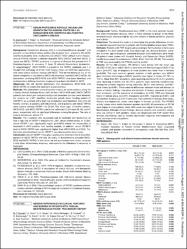Regional differences in disease characteristics of familial mediterranean fever in Turkey: Preliminary report

Göster/
Erişim
info:eu-repo/semantics/openAccessTarih
2021Yazar
Duruöz, M. T.Gezer, H. H.
Melikoğlu, M. Alkan
Hizmetli, S.
Baklacıoğlu, H. S.
Şahin, Nilay
Özer, A.
Öz, N.
Üst veri
Tüm öğe kaydını gösterÖzet
Background: Familial Mediterranean fever (FMF) is a hereditary autoinflammatory disease accompanied by recurrent attacks of fever and serositis. It is prevalent among Mediterranean populations, mainly Turks, Armenians; Jews and Arabs. As genetic factors are variable in the population, environmental factors can also affect phenotypic characteristics.
Objectives: This study aimed to determine the geographic differences in disease characteristics and burden in patients with FMF in Turkey.
Methods: Patients diagnosed with FMF according to the Tel-Hashomer criteria were included in this multi-center study. Patients were included from the different regions of Turkey. Demographic features and clinic characteristics of the patients including disease duration, medications, comorbid conditions, attack characteristics, amyloidosis, acute phase reactants, FMF gene mutations, arthritis, sacroiliitis, and febrile myalgia were recorded. PRASS disease activity score, FMF-QoL, HAD, and HAQ were assessed. Patients from different parts of Turkey were divided into 3 groups the Central Anatolia, Western, and Eastern. Disease activity, characteristics and burden were also investigated among 3 distinct geographic regions.
Results: A total of 281 patients with FMF (195 women, 86 men) were enrolled in this study. The mean age of the patients was 34.9 (SD:12.3) years. While the patients in the eastern areas of Turkey were diagnosed earlier age (p<0.001), the patients in the western area had a longer diagnostic delay time (p<0.001). Patients enrolled from western regions tended to have higher ESR and PRASS scores than those from eastern and central Anatolian regions, but attack numbers per 6 months were similar among the regions. The highest proportion of patients who were M694V/M694V homozygous patients were in western, and then eastern and central Anatolia (19.5%, 18%, and 5.4%). While fever and arthritis were more common in the eastern, pleuritis and sacroiliitis were more common in the central anatolia. Peritonitis and erysipelas like erythema rates were similar among the regions. The majority of patients were receiving colchicine treatment in all three regions. FMF-QoL scores were highest in the eastern and lowest in the western (p=0.006). Patients enrolled in the central Anatolia region experienced more functional disability than those from the western and eastern regions (p=0.009). Anxiety and depression scores were similar between groups (p=0.385 vs p=0.549).
Conclusion: These findings suggest that patients with FMF have diversity concerning the age at diagnosis, diagnostic delay time, disease activity, quality of life, and functional disability among the 3 regions. In the genotypic analysis, the M694V mutation is the most common pathogenic mutation in all regions. Regional genetic and environmental varieties may explain the areal differences. These relationships can occur more clearly in larger patient populations.
References: [1]Ureten K,et al. Demographic, clinical and mutational characteristics of Turkish familial Mediterranean fever patients: results of a single center in Central Anatolia. Rheumatol Int. 2010;30(7):911-915.
Kaynak
Annals of The Rheumatic DiseasesCilt
80Sayı
Supplement 1Bağlantı
https://doi.org/10.1136/annrheumdis-2021-eular.2894https://hdl.handle.net/20.500.12462/12445

















